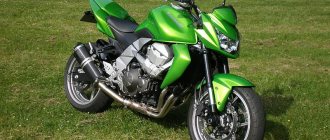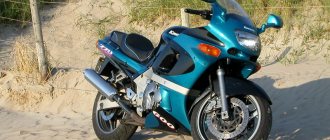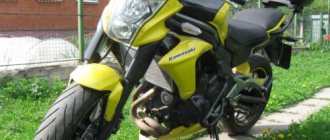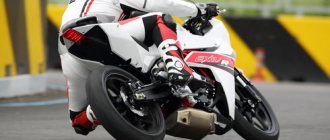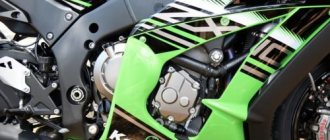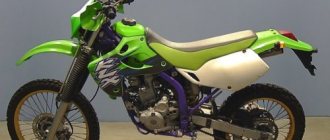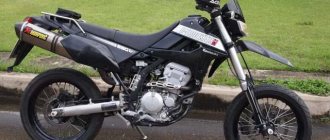As you know, there are no rules without exceptions. And frequent updates don’t always mean working on bugs. A striking example was the Kawasaki KX450F, launched into series in 2005 . Over its 10-year history, the crossover has undergone 7 updates , receiving all new functions and capabilities in a timely manner.
In 2022, the KX450F won the US championship, and in 2022 - podium places in individual races.
Representatives of the developer call the model the flagship of their production and the future winner of world championships. The release of the model continues .
Construction of Kawasaki KX450F
The Japanese based the motorcycle on an aluminum frame assembled according to a perimeter design. This solution made it possible to reduce weight (resulting in increased speed) and also obtain the rigidity necessary for extreme loads.
The aluminum frame is made from forged and cast parts to increase rigidity.
Already in 2007, an inverted fork Kayaba AOS concern’s own development (stay diameter - 49 mm ). By changing individual engine settings, traction increases throughout the entire speed range. At the same time, the brake system and rear mono-shock absorber are being changed. The working suspension travel is 305 mm .
Plastic casing on the front fork.
Fully adjustable rear shock absorber.
Large diameter compression regulator.
Since 2011, due to fundamental changes in electronics, the need for a powerful battery has disappeared, which has a beneficial effect on driving characteristics. Launch Control system allows you to reduce slipping at start, the ability to change shock absorber settings, change the position of the footpegs and steering wheel, and adjust the ECU (control unit) in the field - this is not a complete list of innovations that the bike has received during its evolution.
To manually tune the “brains” of the motorcycle, you need a special kit (purchased separately).
Appearance
Externally, the motorcycle fully meets the characteristics of a sports equipment designed for competitions and serious training.
Left view.
Front view.
Right view.
The absence of front/rear optics, mirrors and a windshield will not make it possible to register the model with the State Traffic Safety Inspectorate (accordingly, there is no PTS - this is sports equipment ), and the short service interval excludes the use of the bike outside of racing tracks.
Front end
- The design of this part is familiar to everyone interested in motorsports. toothy tire, designed for dirt tracks, large, high raised front fender and straight steering wheel.
Green wing.
Number plate.
- It’s interesting that the plate for the number is oval . An invention of the design department or saving material?
- Upon closer examination, it is noticeable that the continuation of the wing is the structure that limits the motor from the sides . This solution made it possible to cover the engine from dirt flying from the front wheel, and at the same time protect it when trying to “lay down” the bike. But the number of holes in the plate passing under it makes us seriously think about its protection.
- Mirrors, windshield, turn signals are not provided for by the design.
The handlebar is low and can be installed in one of four positions depending on the size of the rider.
Dashboard
To save space and weight, no instruments are provided to the user. The developers note that:
- The motorcycle is racing, settings are made before the race.
- The steering wheel is adjustable.
Based on these points, and also in an effort to make a more “knocked down” layout, the instrument panel was sacrificed. However, if the user wants, you can install a speedometer. All contacts are available .
There is a place for an electronic gadget on the frame between the fork and the gas tank.
Rear end
The rear end of the Kawasaki flagship also does not change the traditions of racing models.
Kawasaki KX450F - rear view.
It is characterized by sharp and short body kits, a long sharp stem above the rear wheel, the absence of standard places for optics, and a muffler raised right under the frame.
The silencer is attached through an eyelet almost flush to the rear fender of the motorcycle.
- Motorcycle gets signature green color, while on some models the top of the saddle has the same shade as the stem behind it. It itself is classic for racing and enduro versions, designed for the athlete to stand on the pegs for most of the race.
Smooth and flat saddle, typical of racing bikes.
- The gas tank is hidden under the upper part of the frame, the neck is located in place of the instrument panel. Holds 6.3 liters . According to sports teams, if you fill it up to the throat, you can fill 6.5 liters, but in most standard situations this glass does not make a difference.
Rear tire – 120/80-19 63M with cross tread.
Review of the Kawasaki KLX 450 (KLX450R) motorcycle
As soon as I got on the motorcycle, it became clear that the ergonomics, unlike the TT600E, are all right: the correct footrests, at the right width, a small tank that does not interfere with movement, and the stock Renthal 7/8″ steering wheel feels quite comfortable. The Kawasaki seemed quite compact, light in comparison with the TT, but heavy in comparison with the KTM SX250 KF. Despite the “wonderful” weather, I drove through garages last weekend, driving around large puddles in the dark. I understood almost nothing. It doesn’t want to go “tyr-tyr-tyr” from the bottom, like the TT600E. Requires clutch or gas. If you give it gas, it starts to go crazy. Always ready to drive in the back. It seems that the character is not simple... In the 3rd place it is not enough to open the gas, I did not turn on the 4th. The suspension doesn't notice the holes, but is perhaps a bit softly tuned; first, the rear shock absorber spring needs to be tightened. And you need to work on tuning the engine, since the installed FMF Q4 has a Dynojet kit, which is not installed, and the diffuser must be removed from the air filter housing. It is possible that then the pull below will become better. In short, never the KTM EXC525, but also not the Yamaha WR450F Don Eduardo. On that WR450F I felt more confident. These are first impressions.
I've owned it for less than six months. Before that there was a TTR-250 Open Enduro, compared to Kawa it’s just a baby. Also owning sports for more than 6 years, last ZX-10R (2005). Now for the main thing, the Kawasaki KLX-450R. I bought it from scratch in the salon at a reasonable price this year 2011 i.e. When we started it, the sound of the engine did not particularly inspire the data that is available on the net. After the first 100 km of running-in, the throttle valve was opened approximately halfway, which immediately delighted the locomotive traction from the very bottom. The stock rear sprocket was 50 and was replaced with a 48. The result of the transmission is longer, the traction is still the same, the only thing is that I stopped getting up from the gas in 3rd gear, but the ride has become more comfortable, I have to jerk the gearbox less, because driving through the forest and rural roads is mainly in 2-3 gears, 2nd gear before 50 km/h, then up to 80 km/h 3rd gear, the engine doesn’t really strain, judging by the speed and the open throttle. Oil change every 1000 km. with a filter, I advise you to get a Karcher, because You can only wash it off after packing in the dirt using it. Fully adjustable suspension. Installed by Yoshimura titanium carbon full system $850 and 10 days on eBay + stickers and hand protection, $180. The sound is like a helicopter, especially during reception. In terms of reliability. Mileage 2500 km, 2 oil changes. Turn the bolts very carefully, the torque is indicated in the manual, screw it up and all is well. (I tore everything up on TTR). Replacing the piston according to the manual 1000 km, at first it was annoying, but then it stopped working, it starts the first time with the kick starter and with the electric motor too. There are no unnecessary sounds, except that the clutch is a little noisy at idle, but when you squeeze it all the sounds go away, this is normal as with all manual transmissions. I think if you turn the gas halfway, it will last for a long time. On the net I found a maximum of such a motor with a mileage of 3000 km (according to the owner, alive), the issue of maintenance with replacing the piston every 1000 km was very important. When I drove it to the dacha, I covered 750 km in 3 days. more than 200 per day. So estimate 4 days and replace the piston ha ha ha. The fifth point gets very tired, the seat is narrow and hard. It slips in all gears when driving on dirt with a 48th sprocket. Three falls, the mot is alive, no scratches. Doesn't burn oil. Petrol is 5-6 liters per hundred, depending on how and what gears you drive. The stars have already been a little worn out, I think this is a specific seasonal expense, the sports kit cost more than 15 thousand and they went before me. In short, a cart for those who understand.
Positive - it drives quickly and well, especially if you take the whistle out of the pipe. Its traction was quite enough for me for rides. It drives up any hill from a standing start, jumps over logs and streams without any problems. The frame, suspension and engine are very good. The gears shift quite clearly, although there is no comparison with the Honda. The suspension is impenetrable and has performed very well off-road. But after it, a chekka like KLX250, jebel, etc. seems like a soft, comfortable sofa...
Negative - the light is so-so and the main thing is, yes, the generator constantly floats, you have to start it with a kick, it killed about three batteries per season. This is a NEW motorcycle that behaves this way, please note. From the shop! The wiring is generally “wonderful”, the red wire turns into blue and vice versa, and this is true even according to the official diagram. I struggled with the electrics for a long time and unsuccessfully, scored, sold. Oh, and it also seemed a little heavy to me for such a technique. But this is a matter of habit.
Bottom line - I liked the bike, but electrical problems kill all the fun. If I weren't a fan of Kawasaki, I would recommend the Honda crf450x)
Dimensions and weight
The initial weight of the motorcycle was more than 120 kg. Using global and proprietary solutions, engineers managed to reduce the weight to 106 kg. Dry mass.
After filling the tank full and adding all the necessary liquids, the weight increases by 7 kg . Curb weight - 113 kg .
Dimensions
A cross bike is a rather big thing, but the rider is in contact with it at only 5 points: the footpegs, handles, and sometimes the “fifth” point sits down on the seat. If at least one of these points is not in place, the pilot does not perceive the bike as a whole, no matter how good it is.
Despite the large number of updates, the external dimensions of the motorcycle have not changed. It has:
- length - 2182 mm;
- width - 822 mm;
- in height - 1277 mm.
Wheelbase and ground clearance are 1482 and 328 mm, respectively.
text from Motorreview:
Denis Panferov,
photo:
editorial archiveThe fashion for asphalt off-road conquerors – supermotards – is gaining momentum everywhere. You can buy a serial device, fortunately, almost every company has such machines in its arsenal. Or you can build it yourself. This fascinating process will be discussed in our materials.
In Moscow, sportbikes are no longer listed. And this despite the good quality of the capital’s asphalt and the excessive width of avenues and streets. Powerful engines, efficient fairings that protect from wind and improve aerodynamics, acceleration to 100 km/h in three seconds - all this is great, but it only works after one in the morning. During the day, in standing traffic jams, a sportbike is more likely associated with pain in the hands, double caution when working with the throttle, heat, sticky sweat and hypertrophied back muscles. A 150cc scooter would be a good alternative, but, like any utilitarian device, it does not have the necessary “aura of cool” and is not taken into serious consideration. There is another reason - the lack of a ring track for full-fledged motorcycles. Dmitrov no longer hosts the ShKMG races, renting a poorly adapted track at the Myachkovo airfield costs more than renting a magnificent track in Brno, talk about the global reconstruction of the Kirov Stadium can put a huge hairy cross on the Nevsky Ring track in St. Petersburg. There is simply nowhere to race. There are two alternatives: minibikes and supermotos. But switching from a liter to a 40 cc minivan is not the way of the samurai.
Three superbly held stages of the Moscow Open Supermoto Championship in 2005 showed that work can be found for the “unemployed circuit riders”. Mass participation and intensity of passions in the Russian Championship 2006 are guaranteed.
So, the decision is ripe, and the first question is where to start? The main thing is to understand what you need from the results of the project, and based on these considerations, look for a donor. If you plan only for track (professional racing) use, and the cost-saving factor is not worth leaving the apartment with a rolling pin in your hand and a sly smile on your lips, then the algorithm is simple: take a real cross-country motorcycle or a very tough enduro and “sculpt” it from it. It is better not to consider two-stroke engines as a base for construction. The “ragged” characteristics of the engine are not friendly with asphalt, and asphalt, in retaliation, greatly reduces their service life. So four strokes and 400 cubic meters is the minimum. Yes, you don’t really need to sculpt anything there - a pair of 17-inch rims with soft sports tires, a 320 mm floating front brake disc and tighten the hydraulic adjustments in the suspensions. And this, in fact, is the way for the Kulibins, for whom the cockroaches in their heads do not allow them to sleep. It’s much easier (and sometimes even cheaper) to buy a ready-made racing supermoto from a European manufacturer (KTM, Aprilia, Husqvarna or TM) and straight from the store to the track.
But what should those who don’t have the funds for two motorcycles or want to ride not only on the track, but also just around the city, do? Then you will have to give up leadership in the championship and approach the choice of “donor” differently. It’s better to take an enduro bike with a full set of lighting equipment (side marker, brake light, headlight, turn signals) as a basis and “sculpt” it from it. The appearance of the “combat” vehicles will not be radically different, but the reliability, convenience in real life and legality of use (and this is an important factor; it will be unpleasant to leave a motorcycle in the impound lot without a PTS and an MTPL policy) of the device will be at its best.
Here is an incomplete list of “donors” suitable for alteration:
– KTM 450-525 MXC (EXC), 640 LC4; – Honda CRF-450X, XR400R, XR650R, XR650L; – Husqvarna TE 450-610; – Yamaha WR450F, TT600, XT600; – Suzuki DR650SE, DR-Z400; – Kawasaki KLX650R, KLX650C, KLR650;
– BMW F650 GS Dakar.
To summarize, it will look something like this: a large-volume four-stroke “single-barrel” enduro on long-travel off-road suspensions.
Go ahead. Wheels are the most important step in building any supermoto. At a minimum, because without them he will remain an ordinary cross bike or enduro, no matter what you draw on the plastic. The diameter of the new wheels is 17 inches, as opposed to 18”–19”–21”, which are installed at the factory. At first, the standard was a front disc of 3.5”–17”, and a rear one of 4.5” and wider with a radius of 17”, but recently, after Moto GP switched to 16.5” wheels, they are often used (only for tracks !) Wheel sizes are 3.5”–16.5” in the front and slightly narrower, 4.25”–17” in the rear. From the point of view of flexibility in the choice of tires, the optimal ones for urban use will still be 17-inch wheels with a width of 3.5" in front and 4.5" in the rear, for “donuts” in sizes 120/70-17 and 160/60-17.
I want to discourage you from using second-hand wheels. You are unlikely to find a 100% analogue in terms of geometry (hub width, brake disc offset, axle diameter, rear sprocket offset) and sprocket-disc mounting. You will have to master programming turret, rotary and CNC milling machines. And the mass (and this will not be ordinary, but unsprung mass, which is much more critical) of cast wheels will be higher than that of spoked ones. Don't invent a bicycle - use spokes. Cast wheels are also not suitable for driving up stairs and jumping off trampolines. They don't like high curbs, steps or landings. The only plus is that they come with tubeless tires, which is useful in case of a puncture. But this problem should soon disappear, because at least one company is already producing tubeless spoked wheels for supermotos. Sales will begin in 2006, and now they are being tested in racing conditions - two teams in the World Championship are already driving them, and the reviews are positive. If you plan to use the device as a means of long-range shooting, then it’s worth taking the trouble. You can only rip a tire off a regular supermoto rim at a tire shop - the tubeless geometry of the tire bead is combined with a tube inside, so there’s no way you can help yourself on the side of the road with a kind word and a tire iron.
Wheels are made up of three main components: hub, spokes and rim. The most budget-friendly way is to buy new rims and “supermoto” spokes (they are stronger, shorter and thicker than standard ones) and re-spoke. The budget for such an operation would be approximately $250 (rim) + $100 (spokes) + $100 (labor) × 2 wheels = $900. When ordering rims and spokes, don't miss out! There are hubs and rims for 32 and 34 spokes. The number of holes in the hubs and rims must match not only each other, but also the number of spokes. The downside of this operation is that you have to throw away the standard rims, tires and spokes. What if you want to travel around the Russian outback in the summer or stir up mud in the fall and winter? Then it makes sense to invest another $300-600 in hubs and get two full sets of wheels that you can throw on in half an hour and enjoy the versatility of the motorcycle. By using stock hubs you will save on brake discs, rear sprocket and bushings. They can simply be moved from one wheel to another. If you use tuning hubs, you won’t be able to tailor them, but the overall rigidity of the structure (which is useful at large angles of inclination on a not-too-flat track) can be significantly increased.
If the main use is urban, do not use racing slicks or rain tires. They will “keep” mediocrely (because you won’t be able to warm up the tires to operating temperatures in the city), and they will wear out very quickly. It's also bad to drive on stairs on slicks - the wheel slips. Choose something moderately sporty with tread, or go with dedicated supermoto tires like the Pirelli MT60 Corsa.
While we are comprehending what we read. In the next part we will find out what to do with the brakes, frame, suspension, engine and external paraphernalia. So no goodbyes!
| Previous photo | Next photo |
See article: HOW TO BUILD A SUPERMOTO
Who is it suitable for?
The seat height of the bike is 955 mm, which implies a tall rider . May be uncomfortable for people shorter than 175 cm .
A partial solution to the problem is provided by adjustable footpegs, which, by setting them to the lower position, can lower the center of gravity and reduce the angle of knee bend when driving the motorcycle in a standing position.
Modifications
Since 2008, 2 more versions have appeared in the concern’s line, assembled on the basis of the older model.
- Kawasaki KLX450R — a motorcycle for hard enduro. An electrical circuit has been added to power the headlight and operate the electric starter. The engine is a little stifled in the upper speed range. The suspension has been strengthened and redesigned. Instead of an injector there is a carburetor .
The enduro version is visually distinguished by the presence of an original headlight shape.
- Kawasaki KX450F 53 hp - in its main features it completely repeats the basic version. Engine strangled - 53 mares .
Flaws
Like any equipment that appeared on the market not yesterday, the motorcycle revealed a number of disadvantages.
- General ergonomics of landing . No problems are observed on other models of similar engine volume.
- Handling - the powerful engine does not allow you to take sharp turns normally.
- Swing - by installing a rear swingarm of increased length, the developers managed to solve the problem with the rear, but a problem arose at the front. Experts recommend slightly raising the fork legs in the yokes. If you have the finances, it is recommended to completely replace the original traverse with a tuned one.
The chain deserves a separate discussion. On this model, due to the powerful and evil engine, the chain is a consumable item . You need to check and tighten it before every trip. There were situations when the chain simply broke.
The chain tensioner roller has a toothed pulley.
and dignity
The main and main advantage of the motorcycle is its engine.
There are also mixed opinions about the suspension. In most cases, they are positive, but there are wishes to make its setting not stepwise, but smooth, like other bikes of the concern.
Kawasaki KLX450R vs Yamaha WR450F
Kawasaki KLX450R vs Yamaha WR450F
The Kawasaki KLX traces its lineage directly to the KX450F, the green bike that James Stewart rode to dominate the AMA Supercross series. This is common practice in the development of enduro bikes. In turn, the Yamaha WR450F, introduced in 1998, is a direct offshoot of the YZ450F motocross model.
So we have a ground-up KLX450R and a completely redesigned WR450F. What better way than to take them for a comparative test drive?
To determine the winner, we took these dirt bikes through the Arizona desert, gave them a hard time in Baja California, climbed the peaks of the Paiute Mountains, raced them around our secret enduro test track, and topped it all off with a day of open desert riding. Mojave. In other words, we put them through every possible off-road test, covering over 800 miles on each one.
Kawasaki KLX450R
| pros | Minuses |
| Does not require additional settings | Insufficiently bright headlight |
| Brings Kawasaki back to off-road | Low mounted engine |
| Good range | |
| Smooth clutch operation |
The distance traveled was easy to determine as both bikes are equipped with digital odometers and dual trip meters. They are also equipped with a clock, and the WR450F also has an adjustable enduro timer. Both models feature running boards, headlights, taillights, push-button start, large fuel tanks with reserve compartments, radiator tanks, 18-inch rear wheels, engine guards, side air intakes and an adventurous exterior design. Of course, the engines and suspensions of both motorcycles are tuned specifically for off-road riding.
In fact, if you compare the suspension on these bikes to that of the thoroughbred motocross bikes from which they are derived, the differences are staggering. Their forks and springs are calibrated not for triple jump landings, but for comfortable absorption of all kinds of uneven terrain: small bumps, large rocky ledges, deep ruts, high-speed jumps and everything else that Mother Earth has prepared.
While both bikes use extremely similar KYB suspension at both ends, the Kawasaki has better fork components. It uses the same oil/air separation system as the KX450F motocross bike, minus the DLC. Yamaha went with the cheaper option, choosing not to equip the WR with the same high-quality internal components found on the YZ450F's suspension. This may explain the $100 difference in the retail price of these bikes, with the WR costing $7,199 and the KLX $7,299.
However, when it comes to overall handling and handling, both bikes hold their own against any off-road bike of the past, including the high-end KTM 450 EXC. While the Yamaha excels in this regard, the KLX still takes the cake for its incredibly smooth ride and perfect balance to truly enjoy riding this green bike.
Yamaha WR450F
| pros | Minuses |
| Excellent handling | In stock condition it does not show all the power |
| The motor comes to life if you uncork it | Aluminum, but not lightweight |
| Suitable for driving on mountain trails | |
| Extra wide footrests |
Some credit for this excellent handling goes to the aluminum frames of these bikes, with the Yamaha having a spine-mounted frame and the Kawasaki a bias-ply frame. Both manufacturers claim that their chosen design provides better mass centralization, giving the chassis the agility of a two-stroke enduro. Both bikes offer easy, quick handling, but the WR has much more precise handling than the KLX. Despite the fact that the installation of new Dunlop 742FA tires on the front wheels kept the difference to a minimum, the WR still takes first place in terms of handling. The rear was also fitted with off-road oriented Dunlop 952 tires. It has greater rigidity and, accordingly, a longer service life compared to stock.
Although the 450 cc engines. capable of burning this rubber in the blink of an eye. Kawasaki was new to the category for 2008, only in its third year producing its competition-focused 449cc liquid-cooled four-stroke engine. To create the KLX motor, Kawasaki took the KX-F engine as a basis, doubled the flywheel weight, added a low-mounted exhaust manifold, adjusted lift and cam timing, trimmed power to meet emissions regulations and installed a higher-ratio transmission. The result is a smooth ride. running motor with impressive torque. Its performance is similar to Honda's CRF450X: the same electric feel, but a freer ride with better top-end traction. Due to recent changes in emission regulations, the 40mm Keihin FCR carburetor cannot be adjusted externally and the needle is in a fixed position. Despite this, the test bike performed excellently everywhere, even at high altitudes.
The same cannot be said about the Yamaha, which had difficulty accelerating and lost power while in the mountains. This is surprising because the WR has a so-called “closed field” setup that includes revised injection. This modification involves removing the throttle retaining bolt and the smallest muffler baffle, cutting the gray wire from the ignition harness and installing a different injection from the Yamaha GYT-R. However, as the name suggests, this modification cannot be used on public roads.
While the WR's 449cc four-stroke engine is stock, it performs like a much smaller engine, but when uncorked, it shows everything it can do. It's crisp at low revs, has good mid-range dynamics and is superb at high revs. This makes the WR noticeably faster than the KLX. Although Yamaha still uses a dry lubrication system, the oil reservoir has been moved into the engine housing for better mass centering. The cylinder angle is made more vertical, and the crankshaft and balancer now have a 50/50 ratio, resulting in a smoother ride. Revised cams, carburetor, intake and exhaust characteristics help deliver higher power at low and mid-range rpms.
Comparing the appearance of these models is very difficult. The plastic body kit looks stylish on both motorcycles. The Kawasaki has a more attractive taillight integrated into the rear fender, while the Yamaha, despite some improvement over the previous version, still looks outdated. But the headlight on the KLX is located too high, and even turning the regulator completely down does not help the situation. The Yamaha still has the best headlight for night riding, although it's brighter than before.
The WR looks slimmer and yet has more room than the KLX. This is not to say that the Kawasaki is completely uncomfortable, but in terms of ergonomics it loses to the Yamaha.
Both bikes have the same fuel tank capacity of 9.55 litres, but the Kawasaki can average 24 kilometers more per fill-up. Around that time. When the WR runs out of fuel completely, the KLX only switches to using up the reserve.
So, the Yamaha WR450F, designed as a trials bike, performs better in challenging terrain, while the Kawasaki KLX450R performs better in high-speed open terrain riding. The “uncorked” WR engine leaves no chance for the KLX, but in stock form the situation is the opposite. In addition, the KLX has better handling and is more tolerant of rider error.
It is very difficult to determine the winner in this pair, but after taking into account all the key factors, we decided to give the palm to Kawasaki. It's head and shoulders above the Yamaha in the desert, can compete with the WR in rough terrain, and is generally more suitable for multi-terrain riding. Particularly impressive is the fact that it does not require any additional settings in connection with emissions: you can simply buy it and immediately enjoy the ride.
Comparative characteristics
| Kawasaki KLX450R | Yamaha WR450F | |
| Price, dollars | 7299 | 7199 |
| Dry weight, lbs. | 267 | 262 |
| Fuel tank capacity, gallons | 2,1 | Same |
| Seat height, inches | 36,7 | Same |
| Footrest height, inches | 15,8 | Same |
| Ground clearance, inches | 12,5 | 12 |
| Wheelbase, inches | 58,5 | 58,7 |
